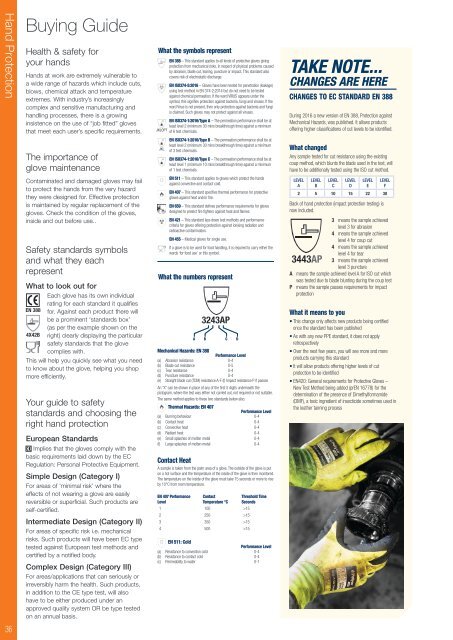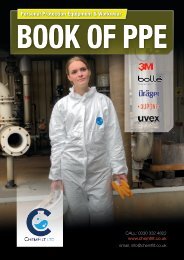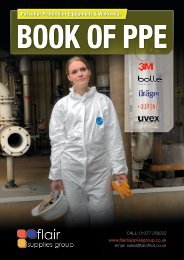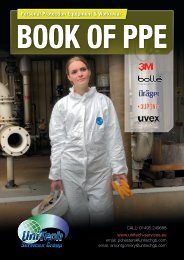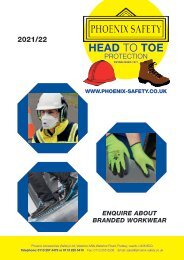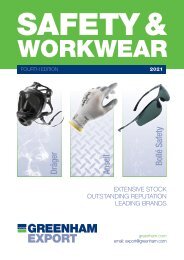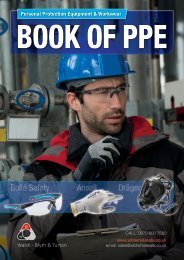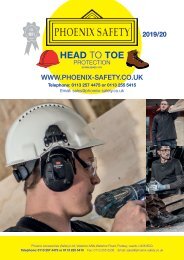Phoenix Safety Head to Toe Protection Catalogue 2021
Phoenix Safety Head to Toe Protection Catalogue 2021
Phoenix Safety Head to Toe Protection Catalogue 2021
Create successful ePaper yourself
Turn your PDF publications into a flip-book with our unique Google optimized e-Paper software.
Hand <strong>Protection</strong><br />
36<br />
Buying Guide<br />
Health & safety for<br />
your hands<br />
Hands at work are extremely vulnerable <strong>to</strong><br />
a wide range of hazards which include cuts,<br />
blows, chemical attack and temperature<br />
extremes. With industry’s increasingly<br />
complex and sensitive manufacturing and<br />
handling processes, there is a growing<br />
insistence on the use of “job fitted” gloves<br />
that meet each user’s specific requirements.<br />
The importance of<br />
glove maintenance<br />
Contaminated and damaged gloves may fail<br />
<strong>to</strong> protect the hands from the very hazard<br />
they were designed for. Effective protection<br />
is maintained by regular replacement of the<br />
gloves. Check the condition of the gloves,<br />
inside and out before use..<br />
<strong>Safety</strong> standards symbols<br />
and what they each<br />
represent<br />
What <strong>to</strong> look out for<br />
Each glove has its own individual<br />
rating for each standard it qualifies<br />
EN 388 for. Against each product there will<br />
be a prominent ‘standards box’<br />
(as per the example shown on the<br />
4X42B right) clearly displaying the particular<br />
safety standards that the glove<br />
complies with.<br />
This will help you quickly see what you need<br />
<strong>to</strong> know about the glove, helping you shop<br />
more efficiently.<br />
Your guide <strong>to</strong> safety<br />
standards and choosing the<br />
right hand protection<br />
European Standards<br />
Implies that the gloves comply with the<br />
basic requirements laid down by the EC<br />
Regulation: Personal Protective Equipment.<br />
Simple Design (Category I)<br />
For areas of ‘minimal risk’ where the<br />
effects of not wearing a glove are easily<br />
reversible or superficial. Such products are<br />
self-certified.<br />
Intermediate Design (Category II)<br />
For areas of specific risk i.e. mechanical<br />
risks. Such products will have been EC type<br />
tested against European test methods and<br />
certified by a notified body.<br />
Complex Design (Category III)<br />
For areas/applications that can seriously or<br />
irreversibly harm the health. Such products,<br />
in addition <strong>to</strong> the CE type test, will also<br />
have <strong>to</strong> be either produced under an<br />
approved quality system OR be type tested<br />
on an annual basis.<br />
What the symbols represent<br />
JKLOPT<br />
JKL<br />
EN 388 – This standard applies <strong>to</strong> all kinds of protective gloves giving<br />
protection from mechanical risks, in respect of physical problems caused<br />
by abrasion, blade cut, tearing, puncture or impact. This standard also<br />
covers risk of electrostatic discharge.<br />
EN ISO374-5:2016 – Gloves have been tested for penetration (leakage)<br />
using test method in EN 374-2:2014 but do not need <strong>to</strong> be tested<br />
against chemical permeation. If the word VIRUS appears under the<br />
symbol, this signifies protection against bacteria, fungi and viruses. If the<br />
word Virus is not present, then only protection against bacteria and fungi<br />
is claimed. Such gloves may not protect against all viruses.<br />
EN ISO374-1:2016/Type A – The permeation performance shall be at<br />
least level 2 (minimum 30 mins breakthrough time) against a minimum<br />
of 6 test chemicals.<br />
EN ISO374-1:2016/Type B – The permeation performance shall be at<br />
least level 2 (minimum 30 mins breakthrough time) against a minimum<br />
of 3 test chemicals.<br />
EN ISO374-1:2016/Type C – The permeation performance shall be at<br />
least level 1 (minimum 10 mins breakthrough time) against a minimum<br />
of 1 test chemicals.<br />
EN 511 – This standard applies <strong>to</strong> gloves which protect the hands<br />
against convective and contact cold.<br />
EN 407 – This standard specifies thermal performance for protective<br />
gloves against heat and/or fire.<br />
EN 659 – This standard defines performance requirements for gloves<br />
designed <strong>to</strong> protect fire fighters against heat and flames.<br />
EN 421 – This standard lays down test methods and performance<br />
criteria for gloves offering protection against ionising radiation and<br />
radioactive contamination.<br />
EN 455 – Medical gloves for single use.<br />
If a glove is <strong>to</strong> be used for food handling, it is required <strong>to</strong> carry either the<br />
words ‘for food use’ or this symbol.<br />
What the numbers represent<br />
Contact Heat<br />
A sample is taken from the palm area of a glove. The outside of the glove is put<br />
on a hot surface and the temperature of the inside of the glove is then moni<strong>to</strong>red.<br />
The temperature on the inside of the glove must take 15 seconds or more <strong>to</strong> rise<br />
by 10°C from room temperature.<br />
EN 407 Performance<br />
Level<br />
3243AP<br />
A B C D<br />
Mechanical Hazards: EN 388<br />
Performance Level<br />
(a) Abrasion resistance 0-4<br />
(b) Blade-cut resistance 0-5<br />
(c) Tear resistance 0-4<br />
(d) Puncture resistance 0-4<br />
(e) Straight blade cut (TDM) resistance A-F (f) Impact resistance P if passes<br />
An “X” can be shown in place of any of the first 5 digits underneath the<br />
pic<strong>to</strong>gram, where the test was either not carried out, not required or not suitable.<br />
The same method applies <strong>to</strong> these two standards below also.<br />
Thermal Hazards: EN 407<br />
Performance Level<br />
(a) Burning behaviour 0-4<br />
(b) Contact heat 0-4<br />
(c) Convective heat 0-4<br />
(d) Radiant heat 0-4<br />
(e) Small splashes of molten metal 0-4<br />
(f) Large splashes of molten metal 0-4<br />
Contact<br />
Temperature °C<br />
1 100 >15<br />
2 250 >15<br />
3 350 >15<br />
4 500 >15<br />
Threshold Time<br />
Seconds<br />
EN 511: Cold<br />
Performance Level<br />
(a) Resistance <strong>to</strong> convection cold 0-4<br />
(b) Resistance <strong>to</strong> contact cold 0-4<br />
(c) Permeability <strong>to</strong> water 0-1<br />
TAKE NOTE...<br />
CHANGES ARE HERE<br />
CHANGES TO EC STANDARD EN 388<br />
During 2016 a new version of EN 388, <strong>Protection</strong> against<br />
Mechanical Hazards, was published. It allows products<br />
offering higher classifications of cut levels <strong>to</strong> be identified.<br />
What changed<br />
Any sample tested for cut resistance using the existing<br />
coup method, which blunts the blade used in the test, will<br />
have <strong>to</strong> be additionally tested using the ISO cut method.<br />
LEVEL<br />
A<br />
LEVEL<br />
B<br />
LEVEL<br />
C<br />
LEVEL<br />
D<br />
LEVEL<br />
E<br />
LEVEL<br />
F<br />
2 5 10 15 22 30<br />
Back of hand protection (impact protection testing) is<br />
now included.<br />
3 means the sample achieved<br />
level 3 for abrasion<br />
4 means the sample achieved<br />
level 4 for coup cut<br />
4 means the sample achieved<br />
level 4 for tear<br />
3443AP 3 means the sample achieved<br />
level 3 puncture<br />
A means the sample achieved level A for ISO cut which<br />
was tested due <strong>to</strong> blade blunting during the coup test<br />
P means the sample passes requirements for impact<br />
protection<br />
What it means <strong>to</strong> you<br />
• This change only affects new products being certified<br />
once the standard has been published<br />
• As with any new PPE standard, it does not apply<br />
retrospectively<br />
• Over the next few years, you will see more and more<br />
products carrying this standard<br />
• It will allow products offering higher levels of cut<br />
protection <strong>to</strong> be identified<br />
• EN420: General requirements for Protective Gloves –<br />
New Test Method being added (prEN 16778) for the<br />
determination of the presence of Dimethylformamide<br />
(DMF), a <strong>to</strong>xic ingredient of insecticide sometimes used in<br />
the leather tanning process


